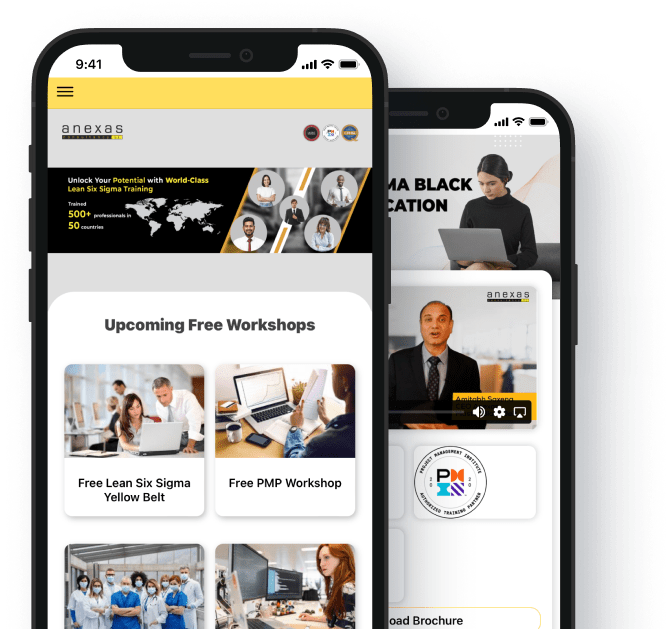Unlocking Operational Excellence: A Comprehensive Guide to Lean Six Sigma Implementation
Introduction Unlocking Operational Excellence
Overview of Operational Excellence
Operational Excellence is a holistic approach to organizational management aimed at continually improving processes, systems, and culture to deliver value to customers and stakeholders. It involves optimizing operations, reducing waste, and enhancing efficiency across all facets of an organization, from production and supply chain management to customer service and administrative functions. Operational Excellence fosters a culture of continuous improvement and innovation, empowering organizations to adapt to changing market conditions, customer needs, and competitive pressures while maximizing performance and profitability.
Importance of Lean Six Sigma
Lean Six Sigma is a methodology that combines the principles of Lean Manufacturing and Six Sigma to improve operational performance and eliminate defects or errors in processes. Lean focuses on eliminating waste and creating value for customers, while Six Sigma aims to reduce variation and improve process quality. Together, Lean Six Sigma provides a comprehensive framework for identifying inefficiencies, streamlining processes, and driving sustainable improvements in productivity, quality, and customer satisfaction. In today’s competitive business environment, where organizations face increasing pressure to deliver high-quality products and services efficiently, Lean Six Sigma has become a cornerstone of operational excellence initiatives, enabling organizations to achieve greater efficiency, agility, and competitiveness.
Purpose of the Guide
The purpose of this guide is to provide a comprehensive overview of Lean Six Sigma implementation, from understanding the fundamentals of the methodology to practical strategies for successful deployment. Whether you are new to Lean Six Sigma or seeking to enhance your organization’s operational performance, this guide will equip you with the knowledge, tools, and best practices needed to unlock operational excellence. By exploring key concepts, methodologies, and real-world case studies, readers will gain insights into how Lean Six Sigma can drive continuous improvement, optimize processes, and deliver tangible business results. Whether you are a business leader, project manager, or aspiring Lean Six Sigma practitioner, this guide will serve as a valuable resource for harnessing the power of Lean Six Sigma to transform your organization and achieve sustainable success.
Understanding Lean Six Sigma
Introduction to Lean Six Sigma Methodology
The Lean Six Sigma methodology is a powerful approach to process improvement that combines the principles of Lean Manufacturing and Six Sigma. It aims to eliminate waste, reduce variation, and improve process efficiency and quality to deliver value to customers and stakeholders. Lean focuses on identifying and eliminating non-value-added activities, such as defects, overproduction, waiting, unnecessary transportation, inventory, motion, and excess processing. On the other hand, Six Sigma provides a structured approach to problem-solving and data-driven decision-making, using statistical tools and techniques to identify root causes of defects and implement sustainable solutions. Together, Lean Six Sigma provides organizations with a comprehensive framework for achieving operational excellence and driving continuous improvement across all aspects of their operations.

Key Principles of Lean Six Sigma
Several key principles underpin the Lean Six Sigma methodology, guiding organizations in their pursuit of operational excellence. These principles include:
- Customer Focus: Understanding and meeting customer needs and expectations are central to Lean Six Sigma, driving decisions and actions that deliver value.
- Process Optimization: Identifying and eliminating waste, inefficiencies, and non-value-added activities to streamline processes and improve efficiency.
- Data-Driven Decision-Making: Using data and statistical analysis to identify root causes of problems, validate improvement efforts, and drive fact-based decision-making.
- Continuous Improvement: Fostering a culture of continuous improvement and learning, where every employee is engaged in identifying opportunities for improvement and implementing solutions.
- Leadership Commitment: Demonstrating strong leadership commitment and support for Lean Six Sigma initiatives, providing resources, guidance, and encouragement to drive success.
DMAIC Framework Overview
The DMAIC framework is a fundamental component of Lean Six Sigma, providing a structured approach to process improvement. DMAIC stands for Define, Measure, Analyze, Improve, and Control, representing the five phases of the improvement cycle.
- Define: The Define phase involves clearly defining the problem or opportunity for improvement, establishing project goals and objectives, and identifying key stakeholders. This phase sets the foundation for the improvement project, ensuring alignment with organizational priorities and customer needs.
- Measure: In the Measure phase, teams collect data to establish baseline performance metrics and quantify the current state of the process. This involves identifying relevant process inputs and outputs, developing measurement plans, and conducting data collection activities using tools such as process maps, check sheets, and data collection forms.
- Analyze: The Analyze phase focuses on identifying root causes of problems or opportunities for improvement using data analysis and statistical techniques. This involves analyzing process data, identifying patterns and trends, and using tools such as Pareto charts, histograms, and regression analysis to pinpoint sources of variation and inefficiency.
- Improve: In the Improve phase, teams develop and implement solutions to address identified root causes and achieve desired process improvements. This may involve brainstorming potential solutions, conducting pilot tests or experiments, and implementing changes using tools such as process redesign, mistake-proofing, and standard work procedures.
- Control: The Control phase involves establishing controls and monitoring systems to sustain process improvements over time. This includes developing control plans, implementing monitoring mechanisms, and establishing performance metrics to track the effectiveness of improvement efforts. Control plans may include procedures for ongoing monitoring, corrective actions, and continuous improvement to ensure sustained success.
Preparing for Lean Six Sigma Implementation
Leadership Commitment and Support
Leadership commitment and support are critical for the success of Lean Six Sigma implementation. It starts with top management demonstrating a clear understanding of the methodology’s benefits and actively championing its adoption throughout the organization. Leaders must allocate resources, provide necessary training and education, and visibly support Lean Six Sigma initiatives to create a culture of continuous improvement and accountability.
Building a Cross-functional Team
A cross-functional team comprising members from different departments and levels of the organization is essential for successful Lean Six Sigma implementation. These diverse perspectives bring varied insights and expertise to the improvement process, fostering innovation and collaboration. Team members should possess a mix of technical skills, problem-solving abilities, and a willingness to embrace change to drive meaningful results.
Identifying Key Improvement Areas
Before embarking on Lean Six Sigma projects, organizations must identify key improvement areas aligned with strategic objectives and customer priorities. This involves conducting thorough assessments of current processes, gathering feedback from stakeholders, and analyzing performance data to pinpoint areas of inefficiency, waste, or customer dissatisfaction. By focusing efforts on high-impact areas, organizations can maximize the return on investment and drive meaningful improvements.
Setting SMART Goals and Objectives
Setting SMART (Specific, Measurable, Achievable, Relevant, Time-bound) goals and objectives is crucial for guiding Lean Six Sigma projects and measuring success. SMART goals provide clarity and focus, ensuring that improvement efforts are targeted and measurable. They enable teams to track progress, evaluate performance against predefined criteria, and adjust strategies as needed to achieve desired outcomes within established timelines.
Establishing Baseline Metrics
Establishing baseline metrics is essential for assessing current performance levels and measuring the impact of Lean Six Sigma initiatives over time. Baseline metrics provide a reference point against which progress can be tracked and evaluated throughout the improvement process. These metrics may include key performance indicators (KPIs), process cycle times, defect rates, customer satisfaction scores, or other relevant measures of performance. By establishing baseline metrics upfront, organizations can objectively evaluate the effectiveness of improvement efforts and make data-driven decisions to drive continuous improvement and operational excellence.
Define Phase: Defining Project Scope and Objectives
Project Selection Criteria
Project selection criteria are essential for identifying suitable improvement projects aligned with organizational goals and priorities. Organizations should establish clear criteria, such as strategic importance, potential impact on key performance indicators, feasibility, and resource availability, to prioritize projects that offer the greatest opportunity for improvement and return on investment. By selecting projects strategically, organizations can focus their efforts on areas that will deliver the most significant benefits and drive sustainable improvements in operational performance.
Stakeholder Analysis and Engagement
Stakeholder analysis involves identifying and understanding the individuals or groups affected by the improvement project and assessing their interests, expectations, and influence levels. Engaging stakeholders early in the Define phase is crucial for gaining buy-in, building support, and ensuring project success. Stakeholders may include internal and external stakeholders, such as customers, employees, suppliers, and regulatory agencies. Effective communication and collaboration with stakeholders throughout the project lifecycle are essential for managing expectations, addressing concerns, and securing necessary resources and support.
Voice of the Customer (VOC) Analysis
Voice of the Customer (VOC) analysis is a key component of the Define phase, focusing on understanding customer needs, preferences, and expectations to inform project scope and objectives. VOC analysis involves gathering feedback from customers through surveys, interviews, focus groups, or other feedback mechanisms to identify critical-to-quality requirements and prioritize improvement opportunities. By incorporating the voice of the customer into project planning and decision-making, organizations can ensure that improvement efforts are aligned with customer needs and deliver value that exceeds expectations.
Developing Project Charters
Project charters are formal documents that define the scope, objectives, deliverables, timelines, and resources for improvement projects. They serve as a roadmap for project execution, providing clarity and direction to project teams and stakeholders. Project charters typically include key elements such as project goals, success criteria, project scope boundaries, roles and responsibilities, risk assessments, and approval signatures. Developing comprehensive project charters ensures that improvement projects are well-defined, scoped, and aligned with organizational priorities, setting the stage for successful execution and achievement of desired outcomes.
Creating SIPOC Diagrams
SIPOC (Suppliers, Inputs, Process, Outputs, Customers) diagrams are visual tools used to map the high-level process flow and identify key elements involved in delivering a product or service. SIPOC diagrams help teams gain a holistic understanding of the process and its interconnected components, including suppliers, inputs, process steps, outputs, and customers. By creating SIPOC diagrams, organizations can clarify process boundaries, identify critical process inputs and outputs, and establish a common understanding of the process among team members and stakeholders. This enables teams to identify improvement opportunities, prioritize areas for intervention, and develop targeted improvement strategies aligned with project objectives and customer requirements.

Measure Phase: Establishing Baselines and Metrics
Data Collection Methods
Data collection methods play a crucial role in the Measure phase of Lean Six Sigma projects, as they provide the foundation for establishing baselines and metrics to quantify the current state of processes. Various data collection techniques, such as surveys, interviews, observation, sampling, and automated data collection systems, may be employed depending on the nature of the process and the types of data required. It is essential to ensure that data collection methods are accurate, reliable, and representative of the process being studied to generate meaningful insights and inform subsequent analysis and improvement efforts.
Process Mapping and Value Stream Mapping
Process mapping and value stream mapping are powerful tools used to visualize and analyze the flow of activities, information, and materials within a process or value stream. Process maps provide a graphical representation of process steps, inputs, outputs, and decision points, helping teams identify inefficiencies, redundancies, and opportunities for improvement. Value stream maps extend process maps to include information flow and value-added activities, enabling teams to identify waste, bottlenecks, and areas for process optimization. By creating process maps and value stream maps, organizations can gain a comprehensive understanding of process flow and identify opportunities to streamline operations and enhance efficiency.
Measurement Systems Analysis (MSA)
Measurement Systems Analysis (MSA) is a critical component of the Measure phase, focusing on assessing the accuracy, precision, and stability of measurement systems used to collect data. MSA evaluates measurement tools, instruments, procedures, and operators to ensure that data collected is reliable and trustworthy for making informed decisions. Common MSA techniques include gauge repeatability and reproducibility (R&R) studies, calibration checks, and accuracy assessments. By conducting MSA, organizations can identify and mitigate sources of measurement error, improve data quality, and enhance the validity and reliability of measurement results.
Establishing Key Performance Indicators (KPIs)
Key Performance Indicators (KPIs) are quantifiable metrics used to measure the performance of processes and track progress towards organizational goals. In the Measure phase, teams identify and establish KPIs that are relevant, measurable, and aligned with project objectives and customer requirements. KPIs may include metrics such as cycle time, defect rate, yield, customer satisfaction scores, and process capability indices. By defining clear KPIs, organizations can monitor performance, identify trends, and make data-driven decisions to drive continuous improvement and achieve desired outcomes.
Conducting Process Capability Analysis
Process capability analysis is a statistical technique used to assess the ability of a process to meet customer specifications and requirements. It involves calculating process capability indices, such as Cp, Cpk, Pp, and Ppk, to quantify the capability of a process to produce products or deliver services within specified tolerance limits. Process capability analysis provides insights into process stability, variability, and performance relative to customer expectations, enabling organizations to identify areas for improvement and implement targeted interventions to enhance process capability and meet customer needs effectively. By conducting process capability analysis, organizations can identify opportunities to reduce defects, improve quality, and optimize process performance to deliver greater value to customers and stakeholders.
Analyze Phase: Identifying Root Causes and Opportunities
Root Cause Analysis Techniques
Root cause analysis (RCA) techniques are essential tools used in the Analyze phase to identify underlying causes of process issues or inefficiencies. RCA techniques aim to delve beyond surface-level symptoms to uncover the fundamental reasons contributing to problems. Common RCA techniques include the 5 Whys, which involves repeatedly asking “why” to drill down to the root cause of a problem, and cause-and-effect analysis, which explores the relationship between potential causes and their effects on the process.
Pareto Analysis and Fishbone Diagrams
Pareto analysis and fishbone diagrams are graphical tools used to prioritize and visualize potential root causes of problems. Pareto analysis helps identify the vital few factors contributing to the majority of problems by ranking them in descending order of frequency or impact. Fishbone diagrams, also known as Ishikawa or cause-and-effect diagrams, categorize potential causes into major categories, such as people, process, equipment, environment, and materials, to systematically identify root causes and their relationships to the problem.
Statistical Analysis Tools (e.g., Histograms, Scatter Plots)
Statistical analysis tools are employed in the Analyze phase to explore relationships between variables, identify patterns, and uncover insights from process data. Histograms provide a visual representation of data distribution, helping teams understand the variability and central tendency of process metrics. Scatter plots depict the relationship between two variables, enabling teams to assess correlations and identify potential cause-and-effect relationships. Other statistical tools, such as regression analysis, analysis of variance (ANOVA), and hypothesis testing, may also be used to analyze data and test hypotheses about the root causes of process issues.
Identifying Waste and Non-value-added Activities
Identifying waste and non-value-added activities is a crucial aspect of the Analyze phase, as it enables teams to pinpoint opportunities for process improvement. Lean principles classify waste into seven categories: overproduction, waiting, transportation, inappropriate processing, unnecessary inventory, unnecessary motion, and defects. By analyzing process flow, cycle times, and value-added activities, teams can identify waste and inefficiencies that detract from overall process performance and customer value.
Brainstorming and Affinity Diagrams
Brainstorming and affinity diagrams are creative techniques used to generate and organize ideas about potential root causes and improvement opportunities. Brainstorming encourages team members to generate ideas freely and without judgment, fostering creativity and innovation. Affinity diagrams organize ideas into logical categories or themes, allowing teams to identify patterns, commonalities, and relationships among ideas. By leveraging brainstorming and affinity diagramming techniques, teams can generate a wide range of potential root causes and solutions, facilitating the identification of actionable insights and improvement strategies.

Improve Phase: Implementing Solutions and Process Optimization
Generating Solution Ideas
The Improve phase of Lean Six Sigma focuses on translating insights gained from the Analyze phase into actionable solutions to address root causes and optimize processes. Teams engage in creative problem-solving techniques, such as brainstorming sessions, to generate a diverse range of solution ideas. These ideas may be based on best practices, industry benchmarks, or innovative approaches that challenge the status quo. By encouraging participation from cross-functional team members and stakeholders, organizations can leverage diverse perspectives and expertise to identify novel solutions that address underlying process issues and drive sustainable improvements.
Designing and Testing Solutions
Once solution ideas have been generated, teams move on to the design and testing phase, where they develop detailed plans and prototypes to implement and validate potential solutions. Designing solutions involves defining implementation strategies, outlining action plans, and specifying resources and timelines required for execution. Teams may create process maps, flowcharts, or mock-ups to visualize proposed changes and facilitate communication. Testing solutions through pilot studies, simulations, or small-scale experiments allows teams to evaluate their effectiveness, identify potential risks or challenges, and refine implementation plans before full-scale deployment.
Piloting and Implementing Changes
Piloting and implementing changes represent the execution phase of the Improve process, where teams deploy selected solutions and monitor their impact on process performance. Piloting involves testing solutions in a controlled environment or specific area of the organization to assess feasibility, gather feedback, and identify opportunities for improvement. Once validated, solutions are rolled out across the organization, and changes are implemented systematically using change management principles and techniques. Effective communication, training, and support are essential during the implementation phase to ensure smooth transition and adoption of new processes by employees.
Lean Tools and Techniques (e.g., 5S, Kaizen)
Lean tools and techniques are instrumental in driving process optimization and continuous improvement during the Improve phase. Tools such as 5S (Sort, Set in Order, Shine, Standardize, Sustain) help organizations create organized, efficient workspaces by eliminating clutter, standardizing procedures, and fostering a culture of cleanliness and discipline. Kaizen, or continuous improvement, encourages small, incremental changes to processes and systems to achieve ongoing improvement. Other Lean tools, such as value stream mapping, kanban, and visual management, are also used to identify waste, streamline processes, and enhance efficiency.
Continuous Improvement Culture
At the heart of the Improve phase is the cultivation of a continuous improvement culture that embraces change, innovation, and learning. Organizations foster a mindset of continuous improvement by empowering employees to identify problems, propose solutions, and participate in improvement initiatives. Leadership plays a crucial role in promoting a culture of continuous improvement by providing support, recognition, and resources for improvement efforts. By embedding continuous improvement into the organizational DNA, organizations can adapt to evolving market conditions, customer needs, and competitive pressures, ensuring long-term success and sustainability.
Control Phase: Sustaining Improvements and Monitoring Performance
Developing Control Plans
The Control phase of Lean Six Sigma focuses on ensuring that improvements made during the project are sustained over time. Developing control plans involves creating detailed guidelines, procedures, and protocols to maintain the gains achieved and prevent regression to previous performance levels. Control plans outline specific actions, responsibilities, and checkpoints to monitor and sustain process improvements. These may include documenting revised processes, updating standard operating procedures (SOPs), and establishing mechanisms for ongoing performance monitoring and feedback.
Implementing Standard Work Procedures
Standard work procedures are essential tools used to ensure consistency and reliability in process execution. In the Control phase, organizations implement standardized work procedures based on the improved processes developed during the project. Standard work procedures define the best-known methods for performing tasks, specifying sequence, timing, tools, and quality standards to be followed. By adhering to standard work procedures, organizations minimize variation, reduce errors, and ensure that processes operate at optimal levels of performance consistently.
Monitoring Key Performance Indicators (KPIs)
Monitoring key performance indicators (KPIs) is a critical aspect of the Control phase, as it allows organizations to track the effectiveness of process improvements and identify any deviations from desired performance levels. KPIs are quantifiable metrics that measure the performance of processes against predefined targets or benchmarks. By regularly monitoring KPIs, organizations can assess the impact of improvement initiatives, identify trends, and take corrective actions to address any issues that may arise. Common KPIs include cycle time, defect rate, customer satisfaction scores, and process capability indices.
Statistical Process Control (SPC)
Statistical process control (SPC) is a methodology used to monitor and control process variation over time. SPC involves the use of statistical techniques and control charts to assess process stability, identify trends or patterns, and detect any deviations from expected performance. Control charts, such as X-bar and R charts, provide visual representations of process data, allowing organizations to distinguish between common cause and special cause variation and take appropriate action to maintain process stability and quality.
Conducting Regular Performance Reviews
Conducting regular performance reviews is essential for ensuring ongoing alignment with organizational goals and objectives. Performance reviews provide an opportunity to evaluate the effectiveness of process improvements, discuss any challenges or issues encountered, and identify opportunities for further optimization. By engaging stakeholders in regular performance reviews, organizations foster accountability, transparency, and continuous improvement. Performance reviews may include reviewing KPIs, analyzing process data, soliciting feedback from stakeholders, and identifying areas for refinement or enhancement to sustain and enhance performance over time.

Overcoming Challenges and Pitfalls
Resistance to Change
Resistance to change is a common challenge encountered during Lean Six Sigma implementation, as it often involves significant shifts in processes, roles, and organizational culture. Resistance may arise from fear of the unknown, concerns about job security, or skepticism about the benefits of change. Addressing resistance requires effective change management strategies, such as communication, education, and involvement of stakeholders in the change process. Leaders must articulate a compelling vision for change, engage employees in dialogue, and provide support and resources to mitigate resistance and foster a sense of ownership and commitment to the improvement journey.
Lack of Data Availability or Quality
A lack of data availability or quality can impede the effectiveness of Lean Six Sigma projects, as data-driven decision-making is central to the methodology. Challenges may arise from fragmented data sources, incomplete or inaccurate data, or inadequate data management systems. Overcoming these challenges requires organizations to invest in data infrastructure, governance, and quality assurance processes to ensure data integrity and reliability. Data collection and analysis methods should be standardized, and efforts should be made to improve data accessibility, transparency, and timeliness to support informed decision-making and continuous improvement efforts.
Inadequate Leadership Support
Inadequate leadership support can hinder the success of Lean Six Sigma initiatives, as leadership commitment is essential for driving organizational change and sustaining improvement efforts. Leaders must actively champion Lean Six Sigma, allocate resources, and create a supportive environment that empowers employees to participate in improvement activities. Lack of leadership visibility, engagement, or alignment with organizational priorities can undermine the credibility and effectiveness of improvement initiatives. By fostering a culture of accountability and leading by example, leaders can inspire confidence, build trust, and motivate employees to embrace Lean Six Sigma as a strategic imperative for organizational success.
Scope Creep and Project Management Issues
Scope creep and project management issues can derail Lean Six Sigma projects, leading to delays, budget overruns, and failure to achieve desired outcomes. Scope creep occurs when project boundaries expand beyond initial expectations, resulting in scope, schedule, or budget changes that undermine project objectives. Effective project management requires clear project definition, scope management, stakeholder engagement, and robust project planning and execution. By establishing clear project charters, setting realistic expectations, and proactively managing risks and dependencies, organizations can minimize scope creep and ensure successful project delivery.
Managing Cultural Shifts
Managing cultural shifts is a fundamental aspect of Lean Six Sigma implementation, as it involves transforming organizational mindset, behaviors, and norms to embrace continuous improvement and innovation. Cultural shifts may involve overcoming resistance to change, challenging traditional ways of thinking, and fostering a culture of accountability, collaboration, and learning. Organizations must invest in cultural change initiatives, such as leadership development, employee training, and recognition programs, to embed Lean Six Sigma principles into the fabric of the organization. By promoting openness, adaptability, and a growth mindset, organizations can create an environment where employees are empowered to drive change, take ownership of improvement initiatives, and contribute to the organization’s long-term success.
Case Studies and Success Stories
Real-world Examples of Lean Six Sigma Implementation
Real-world case studies and success stories provide valuable insights into the application of Lean Six Sigma principles and methodologies across various industries and organizational contexts. These case studies showcase how organizations have successfully implemented Lean Six Sigma to drive significant improvements in operational efficiency, quality, customer satisfaction, and bottom-line results. Examples may include manufacturing companies streamlining production processes to reduce cycle times and defects, healthcare organizations improving patient outcomes and reducing medical errors, and service providers optimizing service delivery to enhance customer experiences. By examining real-world examples of Lean Six Sigma implementation, organizations can gain inspiration, learn from best practices, and identify strategies for overcoming common challenges and achieving success in their own improvement journey.
Key Takeaways and Lessons Learned
Key takeaways and lessons learned from Lean Six Sigma case studies provide valuable insights and guidance for organizations embarking on improvement initiatives. These lessons often revolve around themes such as leadership commitment and engagement, data-driven decision-making, stakeholder involvement, process standardization, and continuous learning and adaptation. Organizations can learn from both the successes and failures of others, understanding what worked well and what pitfalls to avoid in their own Lean Six Sigma journey. Key takeaways may include the importance of setting clear objectives and metrics, fostering a culture of experimentation and learning, empowering frontline employees to drive change, and leveraging technology and innovation to enhance process efficiency and effectiveness. By distilling key insights from case studies and incorporating them into their improvement efforts, organizations can accelerate their progress towards operational excellence and sustainable competitive advantage.
Conclusion
In conclusion, Lean Six Sigma represents a powerful framework for achieving operational excellence and driving continuous improvement within organizations. Through the systematic application of Lean principles and Six Sigma methodologies, organizations can streamline processes, reduce waste, enhance quality, and deliver greater value to customers and stakeholders. The journey from problem identification to solution implementation involves several distinct phases, each with its own set of tools, techniques, and challenges. From defining project scope and objectives to sustaining improvements and monitoring performance, Lean Six Sigma offers a structured approach to driving meaningful change and achieving tangible results. However, success requires more than just technical expertise; it also demands strong leadership, effective communication, stakeholder engagement, and a culture of continuous improvement. By embracing Lean Six Sigma as a strategic imperative and fostering a culture of excellence, organizations can unleash the full potential of their people and processes, driving sustainable growth, innovation, and competitive advantage in today’s dynamic business environment.

FAQ
What is Lean Six Sigma?
Lean Six Sigma is a methodology that combines principles from Lean manufacturing and Six Sigma to improve efficiency, quality, and customer satisfaction. It focuses on eliminating waste, reducing variation, and continuously improving processes to achieve operational excellence.
What are the main benefits of implementing Lean Six Sigma?
Implementing Lean Six Sigma can result in various benefits, including increased productivity, reduced costs, improved quality, faster cycle times, enhanced customer satisfaction, and higher profitability.
How does Lean Six Sigma differ from traditional Six Sigma?
While traditional Six Sigma primarily focuses on reducing variation and defects, Lean Six Sigma integrates Lean principles to also target waste reduction and process optimization. This combination results in a more holistic approach to improvement, addressing both efficiency and effectiveness.
What are the different Belt levels in Lean Six Sigma, and what do they signify?
Lean Six Sigma offers different Belt levels, including Yellow Belt, Green Belt, Black Belt, and Master Black Belt. Each level signifies a certain level of expertise and responsibility in leading and executing improvement projects, with Master Black Belts typically serving as mentors and coaches to other Belts.
How can organizations measure the success of Lean Six Sigma initiatives?
Success in Lean Six Sigma initiatives is typically measured using key performance indicators (KPIs) aligned with organizational goals and project objectives. Common KPIs include process cycle time, defect rate, cost savings, customer satisfaction scores, and return on investment (ROI).
What are some common tools and techniques used in Lean Six Sigma projects?
Lean Six Sigma projects utilize a variety of tools and techniques, including process mapping, value stream mapping, root cause analysis, Pareto analysis, statistical process control (SPC), control charts, regression analysis, and Design of Experiments (DOE), among others.
How long does it take to complete a Lean Six Sigma project?
The duration of a Lean Six Sigma project can vary depending on factors such as project complexity, scope, resources, and organizational readiness. Projects typically range from a few weeks to several months, with larger, more complex projects taking longer to complete.
What are some common challenges organizations face when implementing Lean Six Sigma?
Common challenges include resistance to change, lack of leadership support, inadequate data availability or quality, scope creep, project management issues, and difficulty sustaining improvements over time.
Is Lean Six Sigma only applicable to manufacturing industries?
No, Lean Six Sigma principles and methodologies are applicable across various industries, including manufacturing, healthcare, finance, services, and government. Any organization seeking to improve processes and achieve operational excellence can benefit from Lean Six Sigma.
How can individuals become certified in Lean Six Sigma?
Individuals can pursue Lean Six Sigma certification through accredited training providers. Certification levels typically include Yellow Belt, Green Belt, Black Belt, and Master Black Belt, with training programs covering relevant concepts, tools, and project work to prepare candidates for certification exams.






